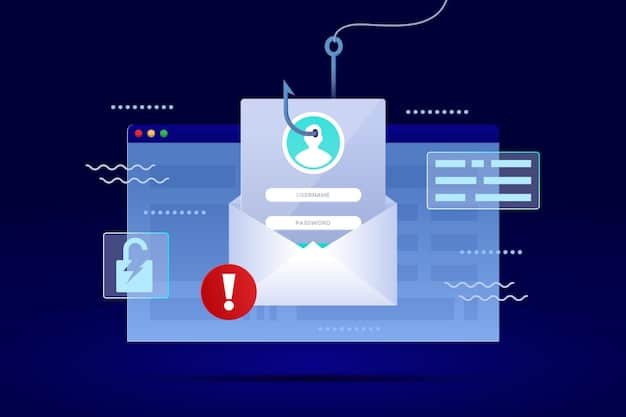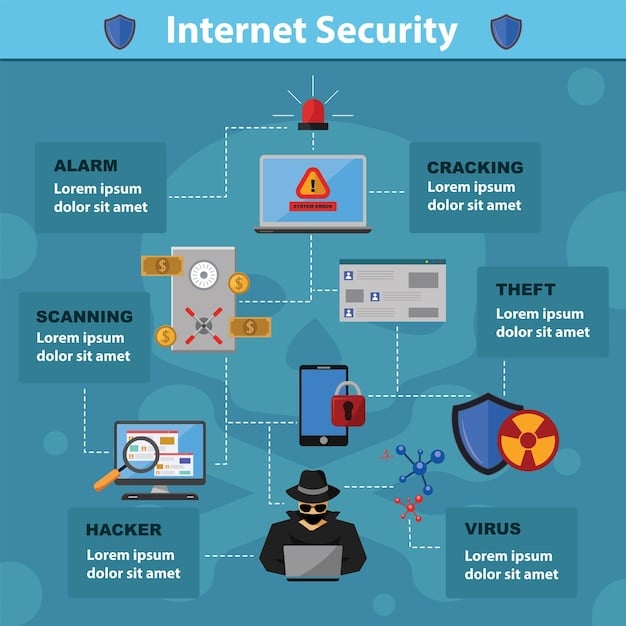Ransomware Attacks Surge 30% in 2025: Protect Your Business Now

With ransomware attacks projected to increase by 30% in 2025, small businesses must proactively implement robust cybersecurity measures, including employee training, data backups, and incident response plans, to safeguard their sensitive data and operational continuity.
The threat of ransomware attacks are up 30% in 2025 paints a grim picture for small businesses. The escalating sophistication and frequency of these attacks demand immediate and comprehensive action. Is your business prepared to weather the storm?
Understanding the Rising Ransomware Threat in 2025
The digital landscape in 2025 reveals a concerning trend: a significant surge in ransomware attacks. Small businesses, often perceived as easier targets than larger corporations, are increasingly in the crosshairs of cybercriminals. Understanding the nature and drivers behind this threat is the first step toward effective protection.
Why the Increase in Ransomware?
Several factors contribute to the projected 30% rise in ransomware attacks. Evolving malware sophistication, the rise of ransomware-as-a-service (RaaS), and the increasing reliance on interconnected digital systems all amplify vulnerabilities. Furthermore, the potential for high financial gains incentivize attackers to target small businesses.
Common Attack Vectors
Ransomware attackers employ a variety of tactics to infiltrate business networks. Phishing emails, malicious attachments, and compromised software downloads remain popular methods. Additionally, vulnerabilities in outdated systems and inadequate security protocols provide entry points for attackers.

- Phishing Emails: Remain a primary delivery method for ransomware.
- Compromised Software: Downloading infected software can introduce ransomware.
- Unpatched Vulnerabilities: Exploiting weaknesses in outdated systems.
In conclusion, the rise of ransomware attacks demands constant vigilance. Small businesses must stay informed about evolving threats, understand common attack vectors, and implement comprehensive security measures.
Assessing Your Business’s Vulnerabilities
Proactive cybersecurity requires a thorough assessment of your business’s unique vulnerabilities. Identifying weaknesses in your defenses allows you to prioritize security measures and allocate resources effectively. Recognizing where you’re most susceptible is the first step in making meaningful improvements.
Conducting a Cybersecurity Audit
A cybersecurity audit involves a comprehensive review of your IT infrastructure, security protocols, and data management practices. This assessment should identify potential vulnerabilities, evaluate existing security measures, and provide recommendations for improvement. A professional audit can give you an unbiased view of your security posture.
Identifying Critical Assets
Understanding what data and systems are most critical to your business functions is crucial. Prioritize protecting these assets above all else. Knowing the true value of your digital assets helps you make informed decisions about security investments.
- Data Encryption: Encrypt sensitive data both in transit and at rest.
- Access Controls: Implement strict access controls and least privilege principles.
- Regular Backups: Maintain frequent and reliable data backups.
In conclusion, a thorough assessment of your business’s vulnerabilities forms the foundation of any effective cybersecurity strategy. Identify critical assets, assess risks, and prioritize security measures to safeguard your business against ransomware attacks.
Implementing Essential Security Measures
Once you’ve identified your vulnerabilities, implementing essential security measures is crucial. These measures act as the first line of defense against ransomware attacks. Building a strong cybersecurity foundation requires attention to detail and consistent implementation.

Deploying Antivirus and Anti-Malware Software
Antivirus and anti-malware software detect and remove malicious code from your systems. Choose reputable solutions that offer real-time scanning and automatic updates. Keeping your software up-to-date is an essential step.
Firewall Protection
Firewalls act as a barrier between your network and the outside world, blocking unauthorized access. Configure your firewall to allow only necessary traffic and regularly review firewall rules.
Employee Education and Training
Your employees are often the weakest link in your security chain. Provide regular training on identifying phishing emails, safe browsing habits, and password security.
- Phishing Simulations: Test your employees’ ability to identify phishing emails.
- Password Policies: Enforce strong and unique passwords.
- Safe Browsing: Educate employees on avoiding suspicious websites.
In conclusion, essential security measures such as antivirus software, firewalls, and employee training form a solid foundation for ransomware protection. Reinforce these defenses through regular updates, monitoring, and ongoing education.
Creating a Robust Backup and Recovery Plan
Even with strong security measures, the possibility of a successful ransomware attack remains. A robust backup and recovery plan is essential for restoring your business operations with minimal disruption. Proper planning and testing can make the difference between a minor setback and a major catastrophe.
Regular Data Backups
Perform regular data backups to an offsite location or cloud storage. Automate the backup process and verify the integrity of your backups regularly. Having backups ensures you can restore your data without paying ransom.
Testing Your Recovery Plan
Regularly test your recovery plan to ensure it works effectively. Conduct simulated ransomware attacks to assess your team’s response and identify any weaknesses in your procedures. Testing helps you refine your plan and improve your response capabilities.
Data Backup Best Practices
Proper data handling is non negotiable, here are some practices.
- Implement the 3-2-1 Rule: Keep three copies of your data, on two different media, with one copy offsite.
- Automate Backups: Use automated backup tools.
- Verify Backup Integrity: Regularly test your backups to ensure they are working.
In conclusion, a robust backup and recovery plan provides a critical safety net in the event of a ransomware attack. Regular backups, thorough testing, and adherence to best practices ensure you can restore your business operations quickly and efficiently.
Developing an Incident Response Plan
An incident response plan outlines the steps to take in the event of a ransomware attack. This plan helps you minimize damage, contain the attack, and restore your systems quickly. A well-defined incident response plan ensures everyone knows their roles and responsibilities during a crisis.
Key Components of an Incident Response Plan
Your incident response plan should include procedures for identifying, containing, eradicating, and recovering from a ransomware attack. Additionally, it should outline communication protocols, roles and responsibilities, and escalation procedures.
Roles and Responsibilities
Clearly define the roles and responsibilities of each member of your incident response team. Assign specific tasks to individuals, such as incident commander, communications manager, and technical specialists. Knowing who is responsible for what streamlines the response process.
Communication Protocols
Establish clear communication protocols for notifying stakeholders, including employees, customers, and law enforcement. Designate a spokesperson to handle external communications and ensure consistent messaging.
- Identify Key Contacts: Create a list of internal and external contacts.
- Establish Communication Channels: Use secure and reliable communication methods.
- Develop Communication Templates: Prepare pre-written messages for common scenarios.
In conclusion, a well-developed incident response plan is essential for minimizing the impact of a ransomware attack. Clearly defined roles, communication protocols, and procedures for containment and recovery ensure a coordinated and effective response.
Staying Informed and Proactive
The cybersecurity landscape is constantly evolving, requiring continuous vigilance and proactive measures. Staying informed about emerging threats and adapting your security strategies is crucial for long-term protection. Continuous learning and adaptation ensure your business remains resilient against evolving cyber threats.
Subscribing to Security Alerts
Subscribe to security alerts and threat intelligence feeds from reputable sources. These alerts provide timely information about emerging threats, vulnerabilities, and attack patterns. Using these feeds can prepare your business and protect its assets.
Regularly Updating Software and Systems
Keep your software, operating systems, and security tools up to date with the latest patches and updates. These updates often address critical vulnerabilities that attackers can exploit. Keep your systems updated to be protected from known exploits.
Cybersecurity Best Practices
Make cybersecurity a central focus for your team and organization.
- Ongoing Education: Promote a culture of cybersecurity awareness.
- Threat Monitoring: Continuously monitor your network for suspicious activity.
- Security Audits: Regularly assess and improve your security posture.
In conclusion, staying informed and proactive is essential for maintaining a strong security posture. Subscribing to security alerts, updating software, and promoting a culture of cybersecurity awareness ensure your business remains resilient against evolving threats.
| Key Point | Brief Description |
|---|---|
| 🛡️ Vulnerability Assessment | Identify and address weaknesses in your cybersecurity defenses to minimize potential entry points for attackers. |
| 🔒 Essential Security | Implement key measures like antivirus software, firewalls, and employee training to form a strong security foundation. |
| 💾 Backup & Recovery | Create a robust data backup plan to ensure quick restoration of operations with minimal data loss in case of an attack. |
| 🚨 Incident Response | Develop a clear plan for handling ransomware attacks, outlining roles, communication protocols, and steps for containment and recovery. |
FAQ
▼
Ransomware is a type of malicious software that encrypts a victim’s data, rendering it inaccessible until a ransom is paid. It can severely disrupt operations, lead to data loss, and cause financial damage for small businesses.
▼
Look for red flags such as poor grammar, suspicious links, requests for personal information, and a sense of urgency. Always verify the sender’s email address and contact the sender through a known number if you suspect fraud.
▼
Immediately isolate affected systems to prevent further spread, notify your incident response team, and contact law enforcement. Do not pay the ransom without consulting experts, as there is no guarantee of data recovery.
▼
Backup frequency depends on your business needs but aim for a minimum of daily backups for critical data. Automate the process and verify backups regularly to ensure data integrity and recoverability.
▼
A cybersecurity audit is a comprehensive review of your IT infrastructure, security protocols, and data management practices. It is important because it identifies vulnerabilities and provides recommendations for improving security.
Conclusion
In conclusion, proactive cybersecurity is essential for protecting your small business from the rising threat of ransomware attacks in 2025. By assessing vulnerabilities, implementing security measures, creating a robust backup plan, developing an incident response plan, and staying informed, you can significantly reduce your risk and safeguard your business operations.





